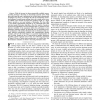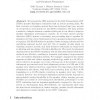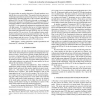ICASSP
2011
IEEE
13 years 4 months ago
2011
IEEE
Splitting a speech signal into speakers is the main goal of a speaker diarization system, which has become an important building block in many speech processing algorithms. Curren...
ICASSP
2011
IEEE
13 years 4 months ago
2011
IEEE
In the last ten years, internet as well as its applications changed significantly, mainly thanks to the raising of available personal resources. Concerning multimedia, the most i...
TASLP
2011
13 years 7 months ago
2011
—With the increase in cheap commercially available sensors, recording meetings is becoming an increasingly practical option. With this trend comes the need to summarize the recor...
TCSV
2008
14 years 5 days ago
2008
This paper presents a bottom-up approach that combines audio and video to simultaneously locate individual speakers in the video (2-D source localization) and segment their speech ...
CLEAR
2007
Springer
14 years 7 months ago
2007
Springer
We present the IBM systems for the Rich Transcription 2007 (RT07) speaker diarization evaluation task on lecture meeting data. We first overview our baseline system that was devel...
ICASSP
2008
IEEE
14 years 7 months ago
2008
IEEE
We report results on speaker diarization of French broadcast news and talk shows on current affairs. This speaker diarization process is a multistage segmentation and clustering s...
MM
2009
ACM
14 years 7 months ago
2009
ACM
The following paper presents a novel audio-visual approach for unsupervised speaker locationing. Using recordings from a single, low-resolution room overview camera and a single f...
ICASSP
2009
IEEE
14 years 7 months ago
2009
IEEE
The following article shows how a state-of-the-art speaker diarization system can be improved by combining traditional short-term features (MFCCs) with prosodic and other longterm...
ICASSP
2009
IEEE
14 years 7 months ago
2009
IEEE
Speaker diarization is originally defined as the task of determining “who spoke when” given an audio track and no other prior knowledge of any kind. The following article sho...



